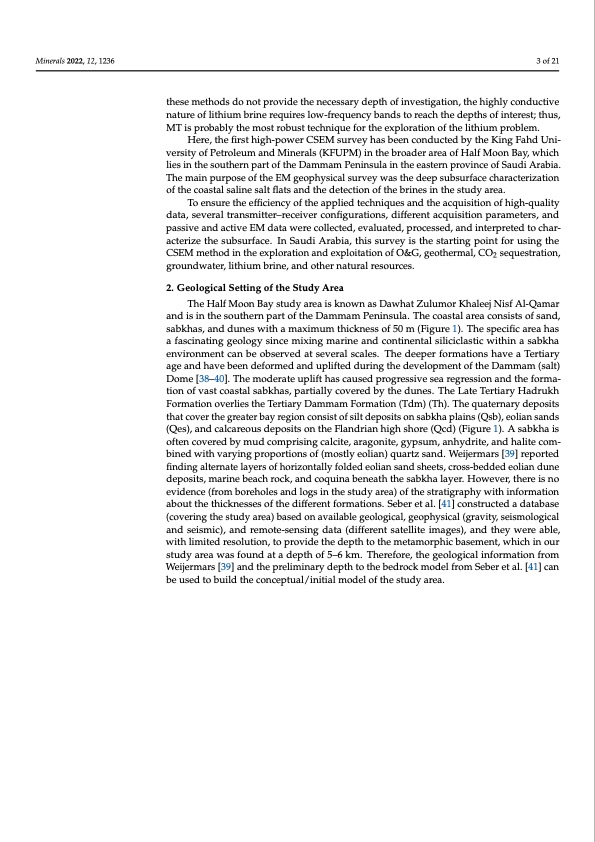
PDF Publication Title:
Text from PDF Page: 003
Minerals 2022, 12, 1236 3 of 21 these methods do not provide the necessary depth of investigation, the highly conductive nature of lithium brine requires low-frequency bands to reach the depths of interest; thus, MT is probably the most robust technique for the exploration of the lithium problem. Here, the first high-power CSEM survey has been conducted by the King Fahd Uni- versity of Petroleum and Minerals (KFUPM) in the broader area of Half Moon Bay, which lies in the southern part of the Dammam Peninsula in the eastern province of Saudi Arabia. The main purpose of the EM geophysical survey was the deep subsurface characterization of the coastal saline salt flats and the detection of the brines in the study area. To ensure the efficiency of the applied techniques and the acquisition of high-quality data, several transmitter–receiver configurations, different acquisition parameters, and passive and active EM data were collected, evaluated, processed, and interpreted to char- acterize the subsurface. In Saudi Arabia, this survey is the starting point for using the CSEM method in the exploration and exploitation of O&G, geothermal, CO2 sequestration, groundwater, lithium brine, and other natural resources. 2. Geological Setting of the Study Area The Half Moon Bay study area is known as Dawhat Zulumor Khaleej Nisf Al-Qamar and is in the southern part of the Dammam Peninsula. The coastal area consists of sand, sabkhas, and dunes with a maximum thickness of 50 m (Figure 1). The specific area has a fascinating geology since mixing marine and continental siliciclastic within a sabkha environment can be observed at several scales. The deeper formations have a Tertiary age and have been deformed and uplifted during the development of the Dammam (salt) Dome [38–40]. The moderate uplift has caused progressive sea regression and the forma- tion of vast coastal sabkhas, partially covered by the dunes. The Late Tertiary Hadrukh Formation overlies the Tertiary Dammam Formation (Tdm) (Th). The quaternary deposits that cover the greater bay region consist of silt deposits on sabkha plains (Qsb), eolian sands (Qes), and calcareous deposits on the Flandrian high shore (Qcd) (Figure 1). A sabkha is often covered by mud comprising calcite, aragonite, gypsum, anhydrite, and halite com- bined with varying proportions of (mostly eolian) quartz sand. Weijermars [39] reported finding alternate layers of horizontally folded eolian sand sheets, cross-bedded eolian dune deposits, marine beach rock, and coquina beneath the sabkha layer. However, there is no evidence (from boreholes and logs in the study area) of the stratigraphy with information about the thicknesses of the different formations. Seber et al. [41] constructed a database (covering the study area) based on available geological, geophysical (gravity, seismological and seismic), and remote-sensing data (different satellite images), and they were able, with limited resolution, to provide the depth to the metamorphic basement, which in our study area was found at a depth of 5–6 km. Therefore, the geological information from Weijermars [39] and the preliminary depth to the bedrock model from Seber et al. [41] can be used to build the conceptual/initial model of the study area.PDF Image | First High-Power CSEM

PDF Search Title:
First High-Power CSEMOriginal File Name Searched:
minerals-12-01236-v2.pdfDIY PDF Search: Google It | Yahoo | Bing
Product and Development Focus for Infinity Turbine
ORC Waste Heat Turbine and ORC System Build Plans: All turbine plans are $10,000 each. This allows you to build a system and then consider licensing for production after you have completed and tested a unit.Redox Flow Battery Technology: With the advent of the new USA tax credits for producing and selling batteries ($35/kW) we are focussing on a simple flow battery using shipping containers as the modular electrolyte storage units with tax credits up to $140,000 per system. Our main focus is on the salt battery. This battery can be used for both thermal and electrical storage applications. We call it the Cogeneration Battery or Cogen Battery. One project is converting salt (brine) based water conditioners to simultaneously produce power. In addition, there are many opportunities to extract Lithium from brine (salt lakes, groundwater, and producer water).Salt water or brine are huge sources for lithium. Most of the worlds lithium is acquired from a brine source. It's even in seawater in a low concentration. Brine is also a byproduct of huge powerplants, which can now use that as an electrolyte and a huge flow battery (which allows storage at the source).We welcome any business and equipment inquiries, as well as licensing our turbines for manufacturing.| CONTACT TEL: 608-238-6001 Email: greg@infinityturbine.com | RSS | AMP |